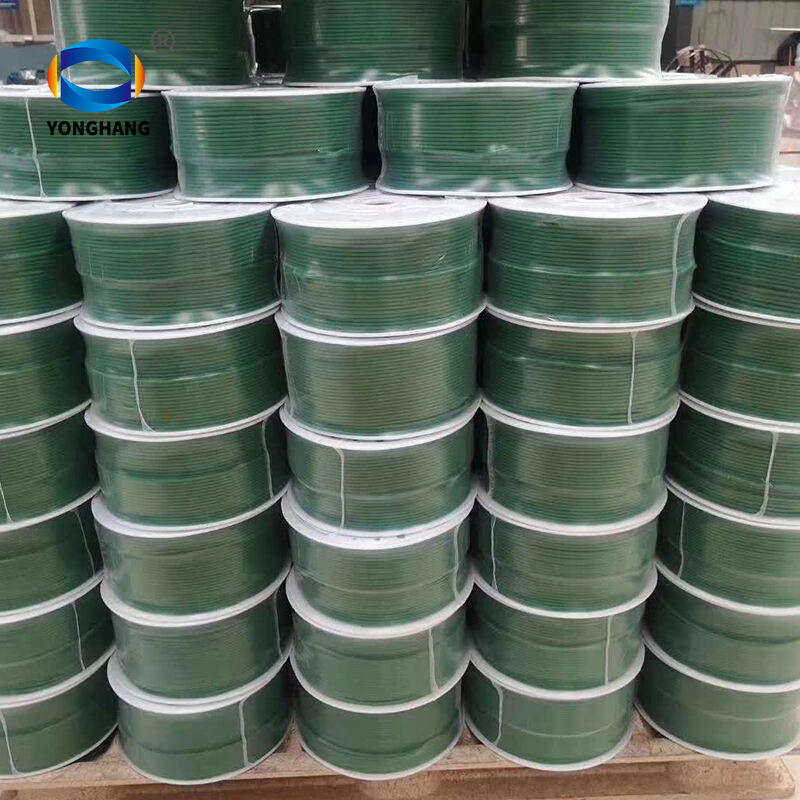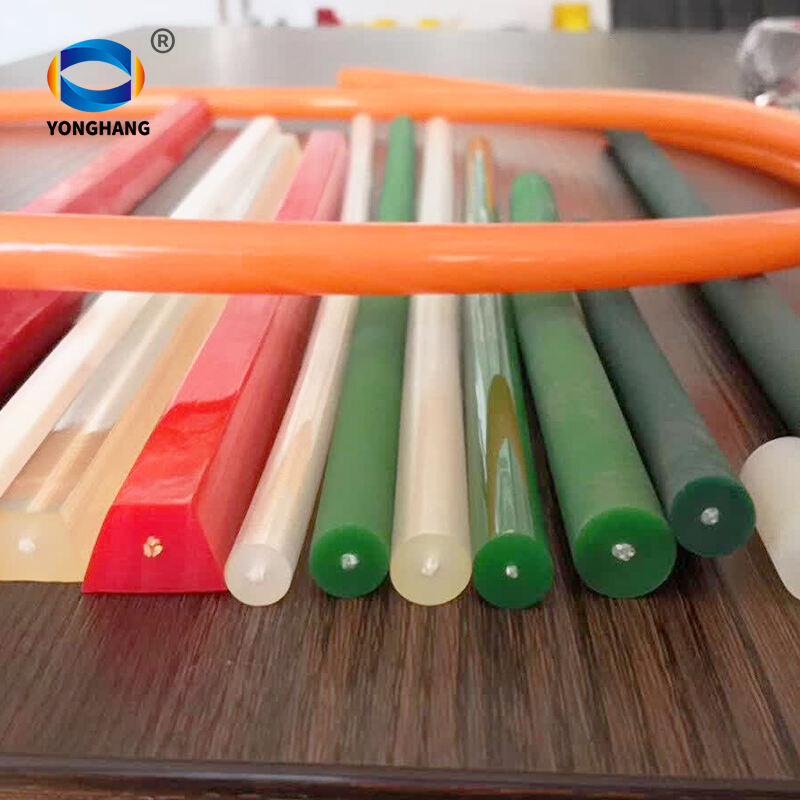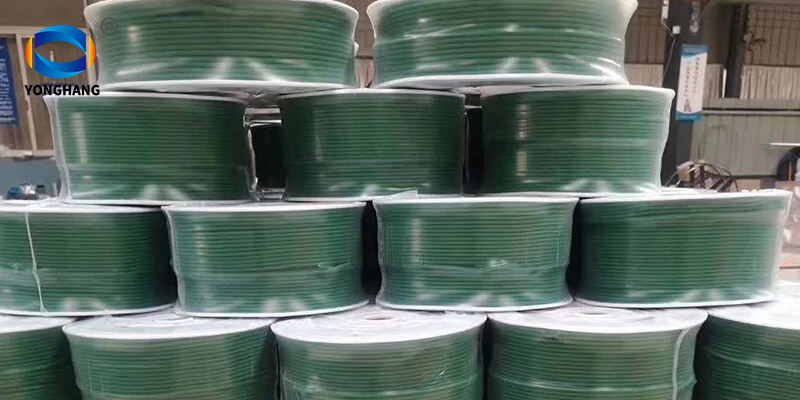How Round Belt Material Composition Impacts Durability
The longevity of round belts really comes down to how the molecules in their base polymer are arranged and how densely they're cross linked. Take natural rubber for instance it just doesn't hold up well because those polymer chains are all over the place. When subjected to repeated stress, it breaks down pretty fast. Polyurethane tells a different story though. Those neat little urethane linkages give it much better resistance to deformation. According to some research published last year in Plastics Today, polyurethane lasts about 42 percent longer when put through these cyclic loading tests. And then there are these super crystalline materials like thermoplastic elastomers. They basically lock everything in place so those polymer chains can't slip around as much. As a result, they keep their tensile strength intact even after going through literally tens of thousands of operational cycles, sometimes over 50,000 or more.
Case Study: Why Rubber Belts Fail Faster Than Polyurethane in Packaging Lines Recent tests on food packaging equipment from 2024 showed something interesting rubber round belts tend to fail about three times quicker than their polyurethane counterparts when exposed to oily conditions. The problem lies in how rubber works its porous nature soaks up all those lubricants over time. After just half a year, this absorption reduces the belt's flexibility by around 17%. Food processors dealing with greasy products face this issue daily. On the other hand, polyurethane belts have these special water-repelling molecular structures that keep them performing well even after months of exposure. Tests revealed they maintained nearly 95% of their original stiffness in similar conditions. This makes a big difference for plant managers who track maintenance costs. Facilities switching to polyurethane reported roughly 28% fewer unexpected shutdowns, which translates into real money saved and better production schedules.
The manufacturing sector is moving toward high tensile synthetic materials these days. More companies are turning to aramid fiber reinforced polyurethanes mixed with silicones because they offer both flexibility and really strong tensile properties, sometimes going beyond 25 MPa in strength tests. According to research published last year in the Polymer Engineering Journal, these new materials crack only about 60% less on their surfaces compared to old school rubber when exposed to harsh UV conditions over time. We've seen adoption rates jump by around 34% specifically in car manufacturing plants lately. The reason? These hybrid synthetics can take on those wild torque changes during operation without getting permanently deformed or damaged, which makes them ideal for many automotive applications where durability matters most.

Comparative Lifespan of Key Round Belt Materials
Rubber Round Belts: Elasticity vs. Degradation in Oily Environments
Rubber round belts offer excellent shock absorption due to natural elasticity but degrade rapidly in hydrocarbon-rich settings. Standard formulations lose 40–60% of tensile strength within 18 months in oily conditions (Elastomer Performance Study 2023). While well-suited for low-speed textile machinery, oil exposure often necessitates protective coatings or material upgrades.
Polyurethane Round Belts: Superior Abrasion Resistance and UV Stability
Polyurethane outperforms rubber in high-friction applications, with service lives exceeding 7,500 hours in automated sorting systems. Its dense molecular structure reduces surface wear by 83% compared to rubber (2024 Material Durability Report). UV-stabilized variants retain flexibility in outdoor environments, making them ideal for solar panel production lines.
| Abrasion Resistance Factor | Polyurethane | Rubber |
|---|---|---|
| Surface Removal Rate (mm/100h) | 0.15 | 0.43 |
| Cover Thickness (mm) | 3.0 | 5.0 |
| Projected Lifespan (hours) | 20,000 | 11,627 |
Lifespan projections are based on the standard abrasion resistance formula for industrial belting.
Silicone Round Belts: Performance in Extreme Temperatures
Silicone round belts work great across a wide temperature range, staying flexible even at -60 degrees Celsius all the way up to 230 degrees without becoming brittle or breaking apart. That makes these belts perfect for both commercial baking operations and cryogenic packaging needs. According to recent testing published in the Polymer Stability Journal last year, these belts still stretch about 92% as much as new ones after going through 2,000 heating and cooling cycles. The fact that silicone doesn't react chemically with most substances means it's well suited for pharmaceutical cleanrooms where contamination risks must be kept to a minimum. However, the price tag does get pretty steep compared to other options, which is why many manufacturers stick with cheaper alternatives when dealing with applications involving heavy wear and tear.

Environmental Factors Affecting Round Belt Service Life
Impact of Humidity and Chemical Exposure on Material Integrity
Material response to moisture and chemicals varies significantly. Polyurethane retains 92% of tensile strength after 1,000 hours at 85% humidity (Magnum Industrial 2023), while rubber degrades 38% faster under the same conditions. Chemical resistance also differs:
| Material | Acid Exposure Performance | Alkali Exposure Performance |
|---|---|---|
| Nitrile Rubber | Poor (40% loss in 6mo) | Moderate (25% loss in 6mo) |
| EPDM | Excellent | Poor |
| Polyurethane | Good | Excellent |
In food processing plants using peracetic acid sanitizers, switching from EPDM to chemical-resistant polyurethane extends round belt lifespan by 73%, according to sanitation compliance reports.
Temperature Fluctuations and Their Effect on Elastomer-Based Round Belts
When temperatures drop below what's called the glass transition point, elastomers start losing their flexibility. Premium polyurethane materials hold up until around -40°C, while regular rubber begins to stiffen at about -20°C. Foundry operators have noticed something interesting too. Their silicone belts tend to outlast traditional options by roughly four times when working environments hit 120°C. The numbers get even more telling from a recent materials research report published last year. Daily temperature swings between 50°C and -10°C can actually speed up belt cracking problems by over two hundred percent in belts that don't meet specification requirements. This kind of information helps manufacturers make better choices about material selection for harsh operating conditions.
Controversy: Do Reinforced Fibers Increase Brittleness Over Time?
Fiber-reinforced belts show 58% higher initial load capacity (ASTM D378), but long-term performance data is mixed:
- Pro-Fiber Camp: Aramid fiber cores reduce permanent deformation by 82% in variable-torque applications
- Anti-Fiber Camp: Embedded fibers create stress concentration points, leading to crack initiation after 200,000+ flex cycles
The 2024 revision of ISO 18100 now requires accelerated aging tests with combined ozone and mechanical stress to better assess real-world durability.
Best Material Selection for Round Belt Applications by Industry
Food Processing: Hygiene Standards and the Rise of Silicone Round Belts
When it comes to food grade round belts, silicone is king in the industry right now. About 78 percent of all new conveyor systems installed last year used FDA approved versions according to Industrial Hygiene Journal data from 2023. What makes silicone so popular? Well, its surface doesn't have pores where bacteria can hide, which works great even when temperatures swing between -40 degrees Celsius and 230 degrees Celsius. Some recent testing looked at how materials hold up in meat processing plants, and what they found was pretty telling. Silicone lasted roughly three and a half times longer than regular rubber under those intense daily pressure washes that are standard practice in poultry facilities.
Automated Assembly Lines: Precision Timing with Polyurethane Round Belts
Polyurethane delivers ±0.1mm dimensional stability and 90 Shore A hardness, making it ideal for robotic pick-and-place systems. Automotive manufacturers report 18–24 month service intervals for polyurethane belts, compared to 6–9 months for rubber. The material’s inherent abrasion resistance is critical in applications requiring sub-0.5mm positional accuracy over 500,000+ cycles.
Textile Machinery: Sustained Flexing Resistance Using Rubber Composites
Neoprene and nylon cord-reinforced rubber blends offer 40% better flex fatigue resistance in loom applications than standard rubber. However, these belts typically require replacement every 8–12 months due to particulate accumulation in high-speed weaving environments.
Strategy: Matching Round Belt Material to Load, Speed, and Cycle Frequency
| Industry | Optimal Material | Key Performance Metric | Operational Thresholds |
|---|---|---|---|
| Pharmaceutical | Silicone | Chemical resistance | 85% ethanol exposure, 10 CIP cycles |
| Packaging | Polyurethane | Tensile strength | 15N/mm², 120 RPM |
| Recycling | Rubber Composite | Impact absorption | 5,000 cycles/day, <5% elongation |
| Precision Robotics | Thermoplastic | Dimensional stability | ±0.05mm over 10⁶ operations |
Selecting the right material requires aligning ASTM F2641 wear rates with specific duty cycles. One automotive plant extended round belt lifespan by 214% simply by switching from generic rubber to oil-resistant polyurethane in gearbox testing rigs.

FAQs
What is the main advantage of polyurethane round belts over rubber?
Polyurethane round belts offer superior abrasion resistance and better performance in oily environments compared to rubber.
Why are silicone round belts preferred in food processing?
Silicone round belts are preferred because their surfaces do not have pores where bacteria can hide, and they can withstand large temperature swings without deteriorating.
How do environmental factors affect the lifespan of round belts?
Environmental factors such as humidity, chemical exposure, and temperature fluctuations can significantly impact the integrity and durability of round belts.
Are there any downsides to using fiber-reinforced belts?
While fiber-reinforced belts increase initial load capacity, they can develop stress concentration points over time, leading to cracks after extensive flexing cycles.

 EN
EN
 AR
AR
 HR
HR
 DA
DA
 NL
NL
 FR
FR
 DE
DE
 EL
EL
 HI
HI
 IT
IT
 JA
JA
 KO
KO
 NO
NO
 PL
PL
 PT
PT
 RO
RO
 RU
RU
 ES
ES
 TL
TL
 IW
IW
 ID
ID
 SR
SR
 SK
SK
 UK
UK
 VI
VI
 TH
TH
 TR
TR
 AF
AF
 MS
MS
 IS
IS
 HY
HY
 AZ
AZ
 KA
KA
 BN
BN
 LA
LA
 MR
MR
 MY
MY
 KK
KK
 UZ
UZ
 KY
KY
